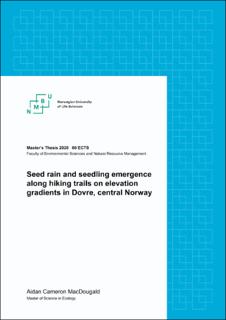Seed rain and seedling emergence along hiking trails on elevation gradients in Dovre, central Norway
Master thesis
Permanent lenke
https://hdl.handle.net/11250/2673027Utgivelsesdato
2020Metadata
Vis full innførselSamlinger
- Master’s theses (MINA) [667]
Sammendrag
Seed dispersal and seedling emergence represent critical events in the life history of plants and are fundamental agents in the formation of plant communities in time and space. Insight into the effects of human movement on these processes has traditionally focussed on roads, however it is assumed that hiking trails also have the ability to function as dispersal corridors. Improving our knowledge of the role of hiking trails on dispersal and community dynamics is particularly relevant as warming global temperatures promote the upslope migration of species and nature-based tourism increases in popularity. I sampled seed rain and recorded seedling occurrence along four mountain hiking trails in Dovre, a popular hiking region in central Norway, and analyzed the data with generalized linear mixed models. I found that seed rain decreased with elevation and, minimally, with distance from the trail. Seedling density decreased away from the trail at lower elevations, but remained level at higher elevations, in concordance with the stress- gradient hypothesis. Standing vegetation coverage was more important than seed rain in mediating seedling emergence, suggesting that seedling emergence is limited by competition for resources rather than seed availability. Seed rain correlated with standing adult vegetation, suggesting localized seed dispersal. My findings suggest that hiking trails in the study area do not represent an ecologically significant dispersal corridor at the scale studied. The topic merits further study as applying the same methodology at a finer scale may reveal meaningful cumulative spatial trends mediated by localized dispersal and microsite characteristics not discovered here.

